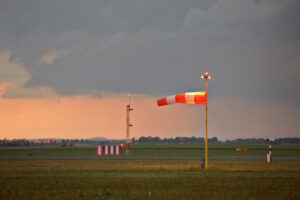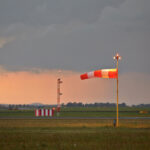Among the various classifications of airspace, Class E airspace often requires a nuanced understanding because of its widespread nature and unique regulations. Whether you’re operating under VFR or IFR, knowing how to fly within, communicate about, and effectively use Class E airspace is critical to mission success.
What is Class E Airspace?
Class E airspace is controlled airspace not classified as A, B, C, or D, nor designated as G (uncontrolled). What makes it unique is its flexibility—it extends from multiple altitudes and locations to facilitate safe and efficient flight operations. Essentially, it fills the gaps between other controlled airspace classes.
Class E airspace begins at different altitudes depending on where it’s located. Here’s a breakdown:
- Surface Areas: Class E can begin at the surface at designated airports, supporting terminal and approach procedures.
- 700 Feet AGL: Often exists around airports to accommodate transitions between the en-route and terminal phases of flight.
- 1,200 Feet AGL and Above: Encompasses general controlled airspace for most areas and supports en-route IFR operations.
- Above Flight Level 600: Covers the airspace above FL600, used for special flights or military operations.
In practice, Class E supports IFR operations but also provides flexible access for VFR traffic. Its adaptability makes it one of the most versatile airspace classes.
The Role of Class E Airspace in Aviation
Class E airspace is designed to manage and protect diverse types of flight operations. Its primary purposes include:
- Supporting IFR Aircraft Operations
Class E provides the controlled environment necessary for IFR pilots to transition between en-route airways, approaches, and departures. - VFR Traffic Accommodations
For VFR flights, Class E airspace does not require communication with ATC (unless otherwise specified), offering flexibility when transitioning through airways or regions. - Extending Controlled Airspace
Class E airspace establishes an interface between terminal airspace and the uncontrolled (Class G) airspace below.
For Part 135 operations, especially those involving scheduled or on-demand flight services, Class E airspace serves as a key route for accessing remote or regional airports. For Part 91 pilots, it often provides a gateway to IFR operations at smaller airports where radar coverage might be limited.
How to Communicate with ATC in Class E Airspace
Effective communication with ATC in Class E airspace depends on the type of operations you’re conducting and the specific airspace provisions:
- For IFR Pilots
You are always required to be in contact with ATC when operating within Class E airspace under IFR. File an IFR flight plan and obtain a clearance before entering Class E. En-route and approach communications will be handed off smoothly between sectors.
- For VFR Pilots
While ATC communication isn’t mandatory under most VFR operations, keeping ATC informed of your intentions can enhance safety—especially in busy airspace or near congested terminal areas. Monitor the appropriate frequency for situational awareness and engage in traffic advisories when necessary.
- Class E Surface Areas
Special consideration is needed when operating in Class E airspace beginning at the surface. These areas often surround smaller public-use airports with published instrument procedures. Pilots must follow the specific communications requirements outlined for the airport in question.
- Transitioning Controlled Airspace
When transitioning from Class G (uncontrolled) to Class E, obtaining flight following or directly contacting ATC enhances situational awareness and ensures a seamless transition to controlled airspace.
Tips for Operating in Class E Airspace
- Obtain traffic advisories even under VFR for increased safety in high-density airspace zones.
- Review the sectional chart carefully to understand where Class E airspace begins and ends, especially around the surface and other altitudes.
- For IFR pilots, ensure you’re prepared for changes in communication frequencies as you transition through sectors in Class E.
- Monitor appropriate ATIS/AWOS frequencies when operating near regional airports within Class E boundaries.
- Use onboard navigation systems and GPS tools when flying VFR for situational awareness and traffic deconfliction.
Special Considerations for Class E Airspace Operations
- Weather Minimums: The weather minimums for VFR flight in Class E airspace vary depending on altitude. Below 10,000 feet MSL, minimums are 3 statute miles visibility and cloud clearance of 500 feet below, 1,000 feet above, and 2,000 feet horizontally. Above 10,000 feet, these minimums increase to 5 statute miles visibility, with 1,000 feet below, 1,000 feet above, and 1 mile horizontally.
- Controlled vs. Uncontrolled Airspace Transitions: When transitioning between Class G and Class E, be aware of the shift from uncontrolled operations to an ATC-monitored environment.
- Special Use Airspace: Be cautious of Special Use Airspace (e.g., Restricted or MOA areas) that may overlap or neighbor Class E. These areas can affect your planned flight path, especially for Part 135 operations in remote areas.
Why Pilots Need Mastery of Class E Operations
Understanding Class E airspace goes beyond compliance—it ensures efficiency, safety, and professionalism. Whether conducting charter services to rural airports or performing private IFR flights, maintaining situational awareness, adhering to communication protocols, and knowing the nuances of Class E can make your operations seamless.
When used effectively, Class E airspace serves as a vital bridge supporting both the terminal and en-route phases of professional aviation. By staying informed and applying best practices, you’ll enhance not only your own operations but also the overall integrity of the National Airspace System.
RELATED CTS TRAINING
RELATED CTS TRAINING









